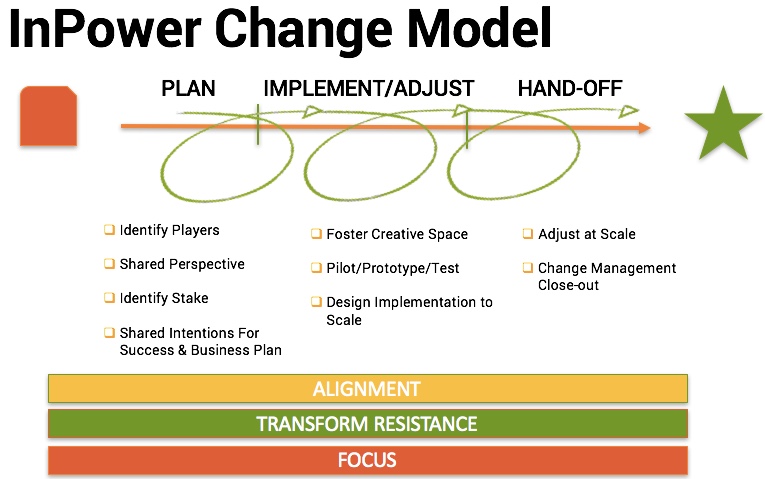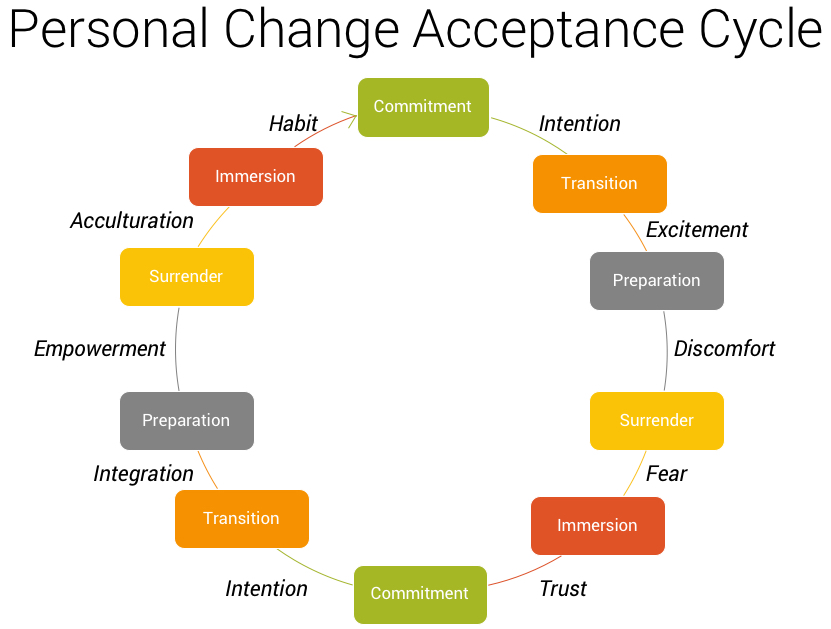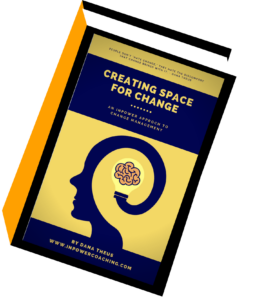Key Takeaways:
- Reframing Change Management: Change management models often fail to account for the internal change needed within individuals for successful implementation.
- Creating the Right Conditions: Successful change management requires preparing, including, and empowering people to participate actively in the change process.
- Safety and Emotional Intelligence: Creating a safe environment where people can manage their emotions is crucial for successful change management, requiring both personal and organizational efforts in emotional intelligence development.
Previously I wrote an article on this blog called Reframing Change Management Theory as an Act of Creation, which summarizes how I’ve come to apply a change management model in my capacity as a coach and leadership consultant. Having helped people and organizations through change all my working life, I’ve come to see the holes in many of the current paradigms. There’s actually nothing wrong with the existing change management models as they are. They work fine if the conditions among and within the human beings using them are right. The problem is that these conditions, which require emotional intelligence, are so rarely right.
And many of these change models take an ‘outside-in’ approach to change. People come in from the outside to decide what needs to be changed and ‘do change to’ the people inside the system. This outside perspective can be very valuable, but it often fails to recognize the power, and necessity, for people to change on the inside in order for change to stick. Achieving this change from the inside out is an art, not a science.
A New Change Management Model
Most change management models work well, when conditions are right. The problem is that conditions are so rarely right.– @DanaTheus <==CLICK TO TWEET
When a change effort goes awry, the change management model is often pinpointed as the problem. The next most blamed element? The people who “resisted” the change. As I discussed in my previous article, it’s my experience that when people are invited into change, rather than having it thrust upon them, they are more apt to accept it and, when the conditions are right, embrace and support it. Most “resistance” they offer is often simply a request to be more involved.
Most serious change efforts these days do try to invite people into the change process to some degree. They get feedback up front, hold charrettes and other creative thinking sessions to involve people and try to communicate to all affected throughout–and at the end–of the process. Agile development processes can also be effective in bringing people into a change process fluidly, on an as-needed basis. However, in my experience, while we’re fairly good at designing processes to bring people into change, we’re not very good at preparing people to participate in these processes, and thus we end up right back where we started, encountering resistance.
Preparing People: Creating the “Right” Conditions for Change
Creating the right conditions for change to take hold means being aware of, and investing in, a process that prepares, includes and empowers people to participate in change at the same time we’re planning to create, test and launch systems and systemic agents of change (e.g., new software systems, new organizational structures and new things designed to replace old things of any kind.) After decades of increasing rates of change we’re pretty good at developing change models that are linear and take us from start (i.e., the As Is beginning state) to finish (i.e., the To Be end state). A lot of these processes look like this InPower Coaching Change Model:

However, preparing people to participate in change requires that we understand how people engage in change successfully. Unlike a fair amount of “common sense” change wisdom, I don’t believe that people always experience change as loss, meaning they have to “grieve” the old thing in order to move on and accept the new thing.
Do you miss your rotary phone? Me either. So why do we say “people hate change”? <– @DanaTheus —CLICK TO TWEET
I do believe that people go through an outside-in-inside-out process of change, however, that enables them to internalize the change being asked of them, make sense of it in their personal context and then participate in it in the way that works for them. How they make it work for themselves is a very personal process, reflecting their worldview, life experience and intentions. In general, it follows the following process for each person.

If you’re an organization or a team leader, what’s the appropriate way to guide people through this very personal process using some kind of cookie cutter change management model? I mean, your goal is to create revenue and business impact, right? Not run therapy groups. The answer looks different in every situation, but it doesn’t require therapy groups. It does, however, involve grooming your managers with the emotional intelligence skills so they can create one key component required to help people navigate the process above: Safety.
Let’s start talking about “change acceptance” and “change empowerment” instead of “change resistance” – @DanaTheus <== CLICK TO TWEET
Safety is the Key to Change Management
It’s true that change is uncomfortable and that people don’t like discomfort. That’s not the same as saying “people don’t like change.” What they don’t like is the discomfort.
Q: So how do we help them become comfortable with change?
A: We learn how to make it okay for them to be uncomfortable as they work through their discomfort and find their way back to comfort (see circle cycle above).
What’s happening during this critical process? What does a safe environment for change and disruption enable? During this adjustment process people are doing the following, at a minimum, and often unconsciously.
- Understanding the new things being asked of them
- Figuring out what will change in their own, personal, sphere at a detail level
- Deciding how they feel about the change, including how they feel about the process of change/how they’re treated
- Dealing with those feelings
- Analyzing alternative behaviors and ways of being in the changed world
- Deciding how they feel about this, and dealing with those feelings
- Imagining their new logistics and orienting to this
- Deciding how they feel about this, and dealing with those feelings
- Envisioning a new definition of personal success for themselves (and their team if they’re a leader)
- Deciding how they feel about this, and dealing with those feelings
- Doing the work to detail what they must do to comply in the changed world (for many, this is significant as it can include revising all their current processes)
- Deciding how they feel about this, and dealing with those feelings
- Doing the work and running into unforeseen challenges
- Deciding how they feel about this, and dealing with those feelings
- Addressing the unforeseen challenges
- Deciding how they feel about this, and dealing with those feelings
- Moving into a “new normal”
- Deciding how they feel about this, and dealing with those feelings
- Deciding to stick with the new normal or move on
- Deciding how they feel about this, and dealing with those feelings
See the pattern? At every step in people’s adjustment to the new order, they will have new feelings, and those feelings must be managed. Actually, using the word “deciding” is probably incorrect. If they’re emotionally intelligent they can notice their feelings and adjust and manage them. Those without emotional intelligence, and who are managed by non emotionally intelligent leaders, rarely even investigate their feelings to decide how to respond. Instead they simply react to them. As a result, many of their feelings won’t be well understood, much less well-expressed.
Normally, these off-the-top feelings and expressions just get blurted out into the space between people, causing unexpected, unconscious and unforeseen feelings in others. When all these feelings start setting off triggers, things can get ugly.
It’s true that change is uncomfortable and that people don’t like discomfort. That’s not the same as saying “people don’t like change.” What they don’t like is the discomfort. – @DanaTheus <=Click to Tweet
Creating safety, to allow these very natural human feelings to exist and be processed without kicking up a dust storm of triggered interactions that simply cascade through the organization, is key but seldom accomplished. Giving people the skills to manage these feelings (including their triggers) is step one, and for that to work there must be a minimal level of safety in the organization so people don’t experience the kind of shame and blame that will shut them down, drive them to resistance and threaten the entire project. How do you create safety? Ah, that is more an art than a science, however, I can boil it down to these basic recommendations, which is what I work with my clients individually and organizationally to achieve.
Personally:
- Learn to detrigger so that you can remain emotionally calm when offering or receiving resistance to change
- Become skilled at exploring resistance with active listening in yourself and others to understand the positive contributions it brings to the process of change
Organizationally:
- Ensure your leaders have higher levels of these emotional intelligence skills and are trained in how to seek and use resistance in developing better change outcomes
- Build basic emotional intelligence skills and vocabulary into the broader team culture: Self-Awareness, Emotional Regulation, Interpersonal Communication and Conflict Management
- Equip executives and senior leaders with how to see and manage the culture to become change resilient and welcoming (which means they must personally learn these lessons so they can model them for others. Want to know why so many change efforts fail? Yup. This.)
Change Management is a Journey
The most successful change management programs work to embed change resilience and related skills into their cultures, and culture shift is a journey. It doesn’t have to take a long time, but it does take time and focus on the part of leaders throughout the organization.
This process is easier when the larger change processes embrace the need for safety, emotional intelligence and employee inclusion and empowerment. To help leaders reframe their preconceptions about Change Management and think about change in ways that allow for safety and space for personal change, I’ve created a White Paper to go deeper than a blog post can really do, which introduced the InPower Change Management Model.

Download a copy of the white paper Creating Space for Change: An InPower Approach to Change Management.
Become a Master Influencer
Updated: Originally posted Feb 2018







